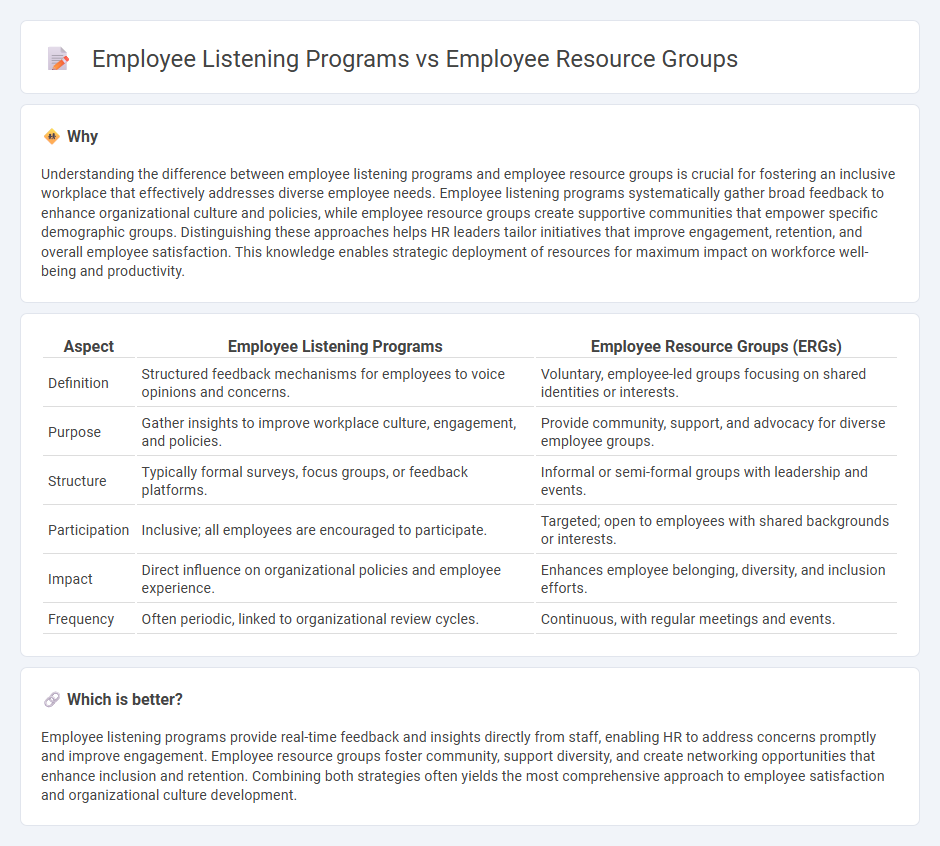
Employee listening programs focus on collecting and analyzing employee feedback through surveys, focus groups, and direct communication to enhance workplace engagement and address concerns. Employee resource groups (ERGs) are voluntary, employee-led collectives that foster inclusion and support for diverse communities within the organization. Discover how integrating both strategies can drive more effective human resources management.
Why it is important
Understanding the difference between employee listening programs and employee resource groups is crucial for fostering an inclusive workplace that effectively addresses diverse employee needs. Employee listening programs systematically gather broad feedback to enhance organizational culture and policies, while employee resource groups create supportive communities that empower specific demographic groups. Distinguishing these approaches helps HR leaders tailor initiatives that improve engagement, retention, and overall employee satisfaction. This knowledge enables strategic deployment of resources for maximum impact on workforce well-being and productivity.
Comparison Table
| Aspect | Employee Listening Programs | Employee Resource Groups (ERGs) |
|---|---|---|
| Definition | Structured feedback mechanisms for employees to voice opinions and concerns. | Voluntary, employee-led groups focusing on shared identities or interests. |
| Purpose | Gather insights to improve workplace culture, engagement, and policies. | Provide community, support, and advocacy for diverse employee groups. |
| Structure | Typically formal surveys, focus groups, or feedback platforms. | Informal or semi-formal groups with leadership and events. |
| Participation | Inclusive; all employees are encouraged to participate. | Targeted; open to employees with shared backgrounds or interests. |
| Impact | Direct influence on organizational policies and employee experience. | Enhances employee belonging, diversity, and inclusion efforts. |
| Frequency | Often periodic, linked to organizational review cycles. | Continuous, with regular meetings and events. |
Which is better?
Employee listening programs provide real-time feedback and insights directly from staff, enabling HR to address concerns promptly and improve engagement. Employee resource groups foster community, support diversity, and create networking opportunities that enhance inclusion and retention. Combining both strategies often yields the most comprehensive approach to employee satisfaction and organizational culture development.
Connection
Employee listening programs gather critical feedback on workplace experiences, enabling Human Resources to identify common issues and areas for growth. Employee Resource Groups (ERGs) provide structured communities where employees can express concerns and share insights, which feed into the listening programs' data collection. Together, these initiatives enhance organizational culture by promoting inclusivity, improving engagement, and informing HR strategies based on authentic employee voices.
Key Terms
**Employee Resource Groups:**
Employee Resource Groups (ERGs) are employee-led communities centered around shared identities, interests, or experiences, fostering inclusion and professional development within organizations. These groups provide a platform for networking, mentorship, and advocacy, directly influencing company culture and policies by amplifying diverse voices. Explore how ERGs can transform workplace engagement and drive meaningful change in your organization.
Diversity and Inclusion
Employee resource groups (ERGs) foster community and support by uniting employees around shared identities or experiences, promoting diversity and inclusion within organizational culture. Employee listening programs systematically collect employee feedback through surveys, focus groups, or interviews to identify inclusion challenges and inform strategic D&I initiatives. Explore more to understand how integrating ERGs and listening programs enhances workforce engagement and drives measurable diversity outcomes.
Affinity Groups
Employee Resource Groups (ERGs) are affinity-based communities within organizations that foster inclusion and support among employees sharing common characteristics such as race, gender, or interests, enhancing engagement and retention. Employee Listening Programs, in contrast, systematically gather employee feedback across all demographics to inform organizational strategy and address workplace concerns. Explore how affinity-focused ERGs create meaningful connections and drive diversity initiatives by learning more about their impact.
Source and External Links
Employee Resource Group - Employee resource groups (ERGs) are workplace groups based on shared characteristics or experiences that provide support, enhance career development, and contribute to personal development.
Benefits of ERGs: Creating Belonging in the Workplace - ERGs promote a sense of belonging among workers by allowing those with common identities or interests to come together, contributing to employee engagement and loyalty.
10 Successful Examples of Employee Resource Groups - This webpage highlights successful examples of ERGs, such as those at Avison Young and Microsoft, demonstrating how these groups foster leadership development and community engagement.
 dowidth.com
dowidth.com